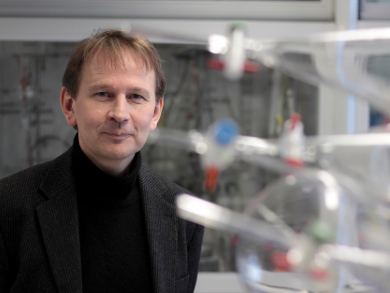Michael Karnahl, University of Stuttgart, Germany, and colleagues, have for the first time synthesized a series of heteroleptic copper(I) photosensitizers (CuPSs) with the general formula [(P^P)Cu(N^N)]+. N^N represents a diimine ligand with an extended π-system at the backbone.The photocatalytic performance of these photosensitizers in proton-reduction experiments was found to be lower than that of related copper photosensitizers. This unexpected behavior was investigated using a series of electrochemical and photophysical measurements, in the hope of determining the source of the bottleneck for catalysis.
Cyclic voltammetry (CV) and transient absorption spectroscopy (TAS) were used to study the anodic shifts and excited states of the CuPSs. The results show that the performance of a photosensitizer does not depend solely on the metal-to-ligand charge-transfer transitions (HOMO-LUMO gap). In fact, advanced substitution schemes have to be developed, which specifically address the orbitals involved in the lowest absorption band to adjust the properties of the excited states (energetic position and lifetime) to improve the photocatalytic activity.
This manuscript represents the 100th paper published in Chemistry – A European Journal featuring Matthias Beller as a (co)author, making him the first author to reach this milestone. Beller, a native to Germany, completed his studies and doctoral thesis in organic chemistry at the Georg-August-Universität Göttingen. Following a postdoctoral stay with K. B. Sharpless, Beller worked at Hoechst AG as project and group leaders of the organometallic and homogeneous catalysis divisions. He then entered academia as Associate Professor in Inorganic Chemistry at the Technical University of Munich. In 1998, Beller became director of the former Leibniz Institute for Organic Catalysis at the University of Rostock e.V. (IfOK) and also a professor in catalysis at the University of Rostock.
Following the success of this institute, Beller helped found and became director of the first Leibniz Institute for Catalysis at the University of Rostock (LIKAT; current address) in 2005. Over the years, Beller has received numerous distinguished awards, given several international lectureships and conference presentations, and he is a member of many editorial boards including Angewandte Chemie, ChemCatChem, Chemistry – A European Journal and chemical societies (GeCatS (German Catalysis Society), GDCh (German Chemical Society). All the while, Beller has continued to lead a successful research program in organometallic chemistry and homogeneous catalysis.
- Heteroleptic Copper Photosensitizers: Why an Extended π-System Does Not Automatically Lead to Enhanced Hydrogen Production,
Martin Heberle, Stefanie Tschierlei, Nils Rockstroh, Mark Ringenberg, Wolfgang Frey, Henrik Junge, Matthias Beller, Stefan Lochbrunner, Michael Karnahl,
Chem. Europ. J. 2016.
DOI: 10.1002/chem.201604005




